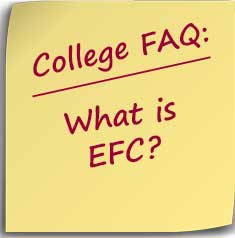 EFC stands for expected family contribution. This is the amount of money families are expected to pay for their students to attend college. Colleges and federal and state governments use the EFC to calculate a student’s financial aid award. The basic theory is that the lower your EFC, the bigger your financial aid award. A family with an adjusted income of $50,000 and two dependents would expect to have an EFC of around $3,800 without considering any other financial assets. A family with income of $100,000, would have an EFC of approximately $20,000.
EFC stands for expected family contribution. This is the amount of money families are expected to pay for their students to attend college. Colleges and federal and state governments use the EFC to calculate a student’s financial aid award. The basic theory is that the lower your EFC, the bigger your financial aid award. A family with an adjusted income of $50,000 and two dependents would expect to have an EFC of around $3,800 without considering any other financial assets. A family with income of $100,000, would have an EFC of approximately $20,000.
Different Ways to Calculate EFC
There are two versions of the EFC, the federal methodology and the institutional methodology.
Federal Methodology
The federal methodology is calculated when the student applies for financial aid by submitting the FAFSA. The federal government uses the EFC to award financial aid such as Pell Grants and Direct Student Loans.
Most schools base their own financial aid awards on the federal methodology although they may make adjustments to their institutional awards based on their own institutional methodology. You can find out which methodologies schools use by looking up the schools on the COLLEGEdata website under the Money Matters tab, Application Process.
Institutional Methodology
There are over 250 colleges and universities, mostly private, that use a completely separate institutional methodology when making financial aid awards. Students still must submit the FAFSA for any federal aid but in order to receive any institutional aid, they must complete the CSS/PROFILE application which is administered by the College Board.
There isn’t any table showing EFC estimates using the Institutional Methodology since it varies by institution. In fact, PROFILE schools may not even ask the same questions–each school decides which questions to include in calculating the EFC. You can see which schools use the PROFILE at the College Board.
Consensus Methodology
There’s actually a third methodology used by 26 colleges referred to as the “consensus” methodology. This group of schools, called the 568 President’s Group, doesn’t use a third form to calculate your EFC. Rather, they use the PROFILE but assess the assets differently, generally in a manner more favorable to families.
Estimating Your EFC
Most students will only have to deal with the FAFSA. However, given how the PROFILE’s Institutional Methodology treats assets differently than the FAFSA, you need to pay attention to which schools do require the PROFILE.
Since the FAFSA formula is standardized and available through the Department of Education, you can get an idea of how much your Federal EFC will be before applying for aid. Troy Onink of Stratagee has a very useful table that provides a quick reference for your EFC based on income. There are various EFC estimators available but only the College Board’s EFC calculator provides Federal and Institutional EFC estimates.
The critical thing to understand about the EFC is that families should consider it the minimum they will pay for college even though the number may not seem realistic. The problem is that there are less than 100 colleges that actually commit to meeting 100% of students’ EFC. The vast majority of colleges do not have the financial resources to meet 100% of EFC.



9 thoughts on “FAQ: What is EFC (Expected Family Contribution)?”